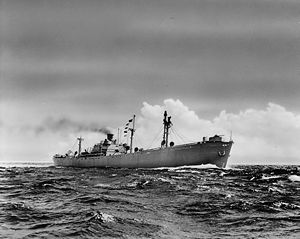
Liberty ships were a class of cargo ship built in the United States during World War II under the Emergency Shipbuilding Program. Though British in concept, the design was adopted by the United States for its simple, low-cost construction. Mass-produced on an unprecedented scale, the Liberty ship came to symbolize U.S. wartime industrial output.

The Casablanca-class escort carrier were a series of escort carriers constructed for the United States Navy during World War II. They are the most numerous class of aircraft carriers ever built. Fifty were laid down, launched and commissioned within the space of less than two years – 3 November 1942 through to 8 July 1944. These were nearly one third of the 143 aircraft carriers built in the United States during the war. Despite their numbers, and the preservation of more famous and larger carriers as museums, none of these modest ships survive today. Five were lost to enemy action during World War II and the remainder were scrapped.
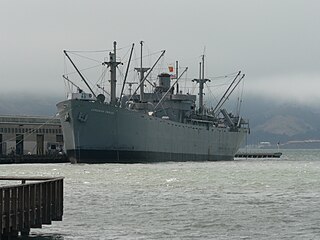
SS Jeremiah O'Brien is a Liberty ship built during World War II and named after the American Revolutionary War ship captain Jeremiah O'Brien (1744–1818).

SS Patrick Henry was the first Liberty ship launched. It was built by the Bethlehem Shipbuilding Corporation at their Bethlehem-Fairfield Shipyard in Baltimore, Maryland. She was named after Patrick Henry, an American attorney, planter, and Founding Father as well as the first and sixth post-colonial Governor of Virginia, from 1776 to 1779 and 1784 to 1786.

SS Martin Behrman was an American Liberty ship built in 1944 for service in World War II. Her namesake was Martin Behrman, long-time mayor of New Orleans, Louisiana. For the was she was operated by the Isbrandtsen Line under charter with the Maritime Commission and War Shipping Administration.

SS A. Frank Lever was a Liberty ship built in the United States during World War II. Her namesake was A. Francis "Frank" Lever. Her sponsor was Mrs. A. Frank Lever.

The Kaiser Shipyards were seven major shipbuilding yards located on the United States west coast during World War II. Kaiser ranked 20th among U.S. corporations in the value of wartime production contracts. The shipyards were owned by the Kaiser Shipbuilding Company, a creation of American industrialist Henry J. Kaiser (1882–1967), who established the shipbuilding company around 1939 in order to help meet the construction goals set by the United States Maritime Commission for merchant shipping.
SS Clara Barton was a standard Liberty ship, Type EC2-S-C1, built by the California Shipbuilding Corporation, Terminal Island, for the United States Maritime Commission and delivered to the War Shipping Administration (WSA) for operation as allocated by WSA during World War II. She was named after Clara Barton, the founder of the American Red Cross. The ship survived the war only to suffer the same fate as nearly all other Liberty ships that survived did; she was scrapped in 1970.
SS Geronimo was a Liberty ship built in the United States during World War II. She was named after Geronimo, a Native American warrior who long fought against American settlers in the Old West.
SS Zachary Taylor was a Liberty ship built in the United States during World War II. She was named after Zachary Taylor, the twelfth President of the United States.
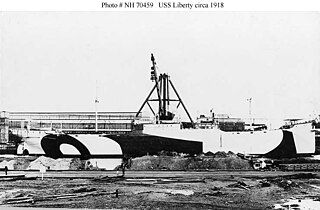
USAT Liberty was a United States Army cargo ship torpedoed by Japanese submarine I-166 in January 1942 and beached on the island of Bali, Indonesia. She had been built as a Design 1037 ship for the United States Shipping Board in World War I and had served in the United States Navy in that war as animal transport USS Liberty (ID-3461). She was also notable as the first ship constructed at Federal Shipbuilding, Kearny, New Jersey. In 1963 a volcanic eruption moved the ship off the beach, and Liberty's wreck is now a popular dive site.
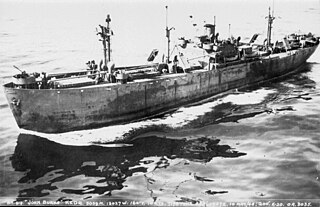
SS John Burke was an American Liberty Ship built during World War II, one of the 2,710 type 'EC2-S-C1' ships that carried all kinds and types of dry cargo during the war. The ship was named for John Burke, the 10th Governor of North Dakota. Burke was built at Kaiser Shipbuilding Company's Oregon Shipbuilding yard in Portland, Oregon. Burke's keel was laid November 20, 1942 and the hull was launched on December 13. After fitting-out, Burke was delivered to the US Maritime Commission on December 23, just 33 days after construction began. The War Shipping Administration then placed Burke under management of the Northland Transportation Company.

SS Pratt Victory was a United States Victory ship which served in the Pacific Theater of Operations during the last few months of World War II. The ship's US Maritime Commission (MARCOM) designation was VC2-S-AP3, hull number 782 (V-782). SS Pratt Victory was named after Pratt Institute in New York City. It was built in 76 days at the California Shipbuilding Yard (Calship) in Los Angeles, California and was delivered on 9 May 1945.

SS Frontenac Victory was a Victory ship built for the United States War Shipping Administration late in World War II under the Emergency Shipbuilding program. It saw service in the European Theater of Operations in the Atlantic Ocean during 1945, and in the immediate post-war period. SS Frontenac Victory was part of the series of Victory ships named after cities; this particular ship was named after the city of Frontenac, Missouri. It was a type VC2-S-AP2/WSAT cargo ship with the U.S. Maritime Commission (MARCOM), "Victory" (MCV) hull number 625, shipyard number 1597, and built by Bethlehem Shipbuilding Corporation in Baltimore, Maryland.
SS Robert Battey was a Liberty ship built in the United States during World War II. She was named after Robert Battey, a Confederate States Army surgeon and later a civilian gynecologist.
SS Robert R. Livingston was a Liberty ship built in the United States during World War II. She was named after Robert R. Livingston, a Founding Father of the United States, a member of the Committee of Five that drafted the Declaration of Independence, the 1st United States Secretary of Foreign Affairs, the 1st Chancellor of New York, and a Minister to France.
SS Nick Stoner was a Liberty ship built in the United States during World War II. She was named after Nick Stoner, a hunter and trapper that served in the Continental Army during the American Revolution and later the United States Army during the War of 1812.

The SS Saginaw Victory was a Victory ship built during World War II under the Emergency Shipbuilding program. It was laid down and launched by the Oregon Shipbuilding Corporation, and completed on February 9, 1945. The ship's United States Maritime Commission designation was VC2-S-AP3 and hull number 152. The Maritime Commission turned it over for merchant navy operation to a civilian contractor, the Pacific-Atlantic Steamship Company under the United States Merchant Marine act for the War Shipping Administration. She was named after Saginaw, Michigan. Victory ships were designed to supersede the earlier Liberty ships. Unlike Liberty ships, Victory ships were designed to serve the US Navy after the war and to last longer. Compared to Liberty ships, Victory ships were faster, longer, wider, taller, and had a thinner stack which was set further forward on the superstructure. They also had a long, raised forecastle.

SS Mary Cassatt was an American Liberty ship built in 1943 for service in World War II. Her namesake was Mary Cassatt, an American painter and printmaker.
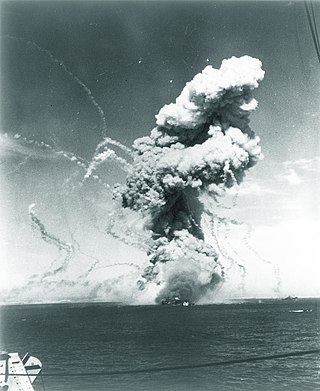
SS Robert Rowan was an American Liberty ship built in 1943 for service in World War II. Her namesake was Robert Rowan, an American politician.
